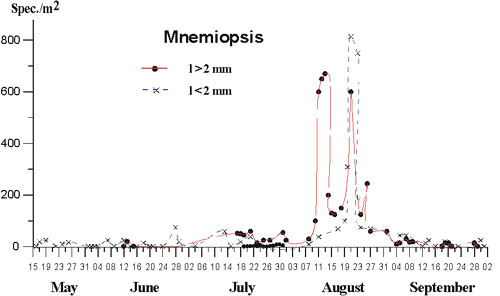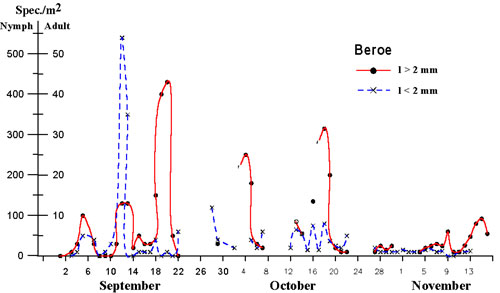|
||
ATTACHMENT 5. Gelatinous Macroplankton (Jellyfish Aurelia aurita, Ctenophores Mnemiopsis leidyi and Beroe ovata) in The Black Sea Ecosystem. (Important aspects for the Caspian Sea modern ecology). M.E. Vinogradov, E.A.
Shushkina and S.V. Vostokov Abstract Three periods can be defined in the Black Sea ecosystem evolution during the last 30 years. Each of them, was characterized by violent development of certain species of gelatinous macroplankton. Until the middle of 80th jellyfish Aurelia aurita dominated in gelatinous plankton of the Sea. Beginning from 1988, the Black Sea basin was conquered by ctenophore Mnemiopsis leidyi. It prevailed in gelatinous macroplankton until the invasion of carnivorous jelly comb Beroe ovata, considered to be specialized predator, feeding on ctenophores of Lobata order. Recorded first in 1997, it gave the explosion in 1999. Each period of the ctenophores explosions was characterized by significant changes in the structure of plankton communities and effected on fish productivity. During last tens of years the Shirshov Institute of Oceanology (IORAS) conducted regular ecosystem investigations in different regions of the Black Sea (Vinogradov et al.,1992). The results enable to estimate the role of gelatinous macroplankton representatives in the Black Sea plankton communities and ecosystem functioning. (Shushkina and Musaeva, 1983; Shushkina and Arnautov, 1985; Shushkina and Vinigradov, 1991a; Shushkina and Vinigradov, 1991b Shushkina et al., 2000). Along the period of Aurelia aurita predominance, the Black Sea ecosystem seemed to be relatively balanced and the fish catches remained at approximately constant level (Vinogradov et al.,1992). The Mnemiopsis leidyi explosion (Vinigradov et al.,1989) exerted considerable effect on the Black Sea ecosystem. The parameters of its invasion was continuously studied for the last 12 years by the group of experts from Shirshov Institute of Oceanology. During this period of investigations the comparison of macro- and mesozooplankton quantity determinations, obtained by different equipment and methods (nets, bottles, underwater video and direct counts from submersibles) was performed. Catchability of different plankton nets used for mezo- and macroplankton collections in the Black Sea IORAS expeditions was also analyzed (Vinogradov and Shushkina 1982; Shushkina and Vinogradov, in press). This work enabled to create the comparable data sets, required for temporal plankton changes analysis and mathematical models development (Lebedeva and Shushkina, 1993). The results obtained, indicates that M. leidyi invasion caused considerable decrease of the forage zooplankton biomass and plankton eating fish catches (Vinogradov et al.,1992 Vinogradov et al., 1995). Moreover, intensive eating out of larval bivalves by M. Leidyi, mentioned in the coastal regions of the north-eastern Black Sea, resulted in considerable reduce of bivalves populations (Kucheruk and Vostokov in press). Potential impact of the ctenophore on benthic communities is the problem of vital importance for the Caspian Sea, because M. leidyi explosion is a real menace to bivalves, which constitute the base for sturgeon fattening. The penetration of another ctenophore Beroe ovata (Vinogradov et al., 2000), opened a new period in the Black Sea ecosystem development and gave the impulse to further investigations of gelatinous plankton in the Black Sea. Comprehensive studies of the new invasion were started by IORAS in 1999. One of the main goals was to estimate B. ovata influence on M. leidyi population and clarify the total impact of the new invader on the structure of plankton communities and ecosystem functioning. Seasonal population dynamics, age structure, basic physiological and ecological characteristics of the new invader and its potential prey Mnemiopsis leidyi were studied in the north-eastern Black Sea from July 1999 to November 2000. During this period of investigations the total number, biomass, size distribution and hunting behavior of M. leidyi, B.ovata and other representatives of gelatinous macroplankton were examined by means different plankton nets, diving technique and underwater video camera. Dry weight, carbon content, length-weight proportion and quantitative parameters of the ctenophores feeding and reproduction were measured in laboratory experiments(Vostokov et al., 2001; Arashkevich et al., 2001). Respiration rates of B. ovata on M. leidyi and weight–specific metabolism were also determined for different size groups of ctenophores. The data on physiological and ecological parameters of B. ovata and M. leidyi were analyzed in relation to the invaders interactions (Vinogradov et al., 2000; Vostokov et al., 2000; Shushkina et al., 2000; Vostokov et al., 2001. The expected influence of B. ovata on the M. leidyi near-shore population was assumed on the base of physiological characteristics determined. Different ways of future ecosystem development were analyzed by means of mathematical modeling. The results enable to conclude that B. ovata can really control the near-shore population of Mnemiopsis leidyi (Vostokov et al., 2001). This conclusion was confirmed by further observations in the near shore waters of the Black Sea. The daily analysis of the M. leidyi population performed during 1999-2000 ( Vinogradov and Shushkina in press) revealed 10-15 days period waives breeding intensity, which increased gradually, reaching the maximum in August (fig. 1).
Figure 1. Mnemiopsis
leidyi abundance in near shore waters Further growth of the population was interrupted in the late August by violent B. ovata development (fig. 2).
Figure 2 Beroe ovata
abundance in near shore wares It resulted in practically total disappearance of M. leidyi from plankton in November - December. The data presented demonstrate the pattern of M. leidyi population growth in spring–summer and its extinction after B. ovata appearance (fig. 1,2). The results reflecting the total impact of B. ovata invasion are not abundant yet. However, the data available, show considerable decline of M. leidyi population (fig. 3). The increase of forage zooplankton biomass in the coastal and open waters is also mentioned. The Intensive reproduction of bivalves, reduced by M. leidyi in previous years and restoration process in benthos communities is pointed out.( Kucheruk and Vostokov in press).
Figure 3. Mnemiopsis
leidyi biomass dynamics in the open waters The further Black Sea ecosystem development depends on stability of B. ovata invasion. In this sense, it should be stressed, that the difference in climatic conditions and water masses circulation between 1999 and 2000, did not prevent B. ovata explosion near the north coasts of the Black sea in 2000. Moreover, in colder temperature schedule of 2000, unfavorable for B. ovata, it demonstrated more active development, then in previous year. In 2001 its presence in plankton was recorded already in spring. B. ovata early appearance in relatively cold period reflects continues adaptation of the ctenophore to the Black Sea conditions. Its population possible development early in the summer can prevent M. leidyi explosion, considered to be regular in July-August. The facts mentioned, gives us ground to conclude that B. ovata invasion is a constant event, which leads to restoration of a forage zooplankton, benthic communities and plankton eating fishes populations in the Black Sea. Referenses
|
Meeting Report
Attachment
1 |
|





